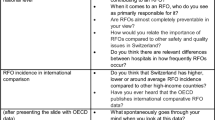Abstract
There has been much debate about patient safety after the release of the landmark report To Err is Human: Building a Safer Health System in 1999 by the Institute of Medicine (IOM) [1]. The authors report 44,000–98,000 deaths per year due to medical errors in the United States. The IOM called for more than 50% decrease in the number of deaths within the 5 years following that publication establishing goals and strategies to achieve this result. These goals include: (1) Establishing a national focus to create leadership, research, tools, and protocols to enhance knowledge. (2) Identifying and learning from errors by developing a nationwide, public, mandatory reporting system, and by encouraging healthcare organizations and practitioners to develop and participate in voluntary reporting systems. (3) Raising performance standards and expectations for improvements in safety through the actions of oversight organizations, professional groups, and group purchasers of healthcare. (4) Implementing safety systems in healthcare organizations to ensure safe practices at the delivery level.
Access this chapter
Tax calculation will be finalised at checkout
Purchases are for personal use only
Similar content being viewed by others
Selected Readings
To Err is Human: Building a Safer Health System. http://www.iom.edu/∼/media/Files/Report%20Files/1999/To-Err-is-Human/To%20Err%20is%20Human%201999%20%20report%20brief.ashx.
Brennan T, Gawande A, Thomas E, Studdert D. Accidental deaths, saved lives, and improved quality. N Engl J Med. 2005;353:1405–9.
Clark J, Johnston J, Blanco M, Martindell D. Wrong-site surgery: can we prevent it? Adv Surg. 2008;42:13–31.
Christian CK, Gustafson ML, Roth EM, et al. A prospective study of patient safety in the operating room. Surgery. 2006;139(2):159–73.
Gibbs VC, Coakley FD, Reines HD. Preventable errors in the operating room – part 2: retained foreign objects, sharps injuries, and wrong site surgery. Curr Prbl Surg. 2007;44:352–81.
Facts about the Universal Protocol – Joint Commission. 2010. http://www.jointcommission.org/PatientSafety/UniversalProtocol/up_facts.htm. Accessed 19 May 2010.
Kwaan M, Studdert D, Zinner M, Gawande A. Incidence, patterns, and prevention of wrong-site surgery. Arch Surg. 2006;141:353–8.
Canale ST. Wrong-site surgery, a preventable complication. Clin Orthop Relat Res. 2005;433:26–9.
Michaels R, Makary M, Dahab Y, et al. Achieving the national quality forum’s “never events” prevention of wrong site, wrong procedure, wrong patient operations. Ann Surg. 2007;245:526–32.
DeVine J, Chutkan N, Norvell DC, Dettori JR. Avoiding wrong site surgery, a systematic review. Spine. 2010;35:S25–36.
Gibbs VC. Patient safety practices in the operating room: correct-site surgery and nothing left behind. Surg Clin N Am. 2005;85:1307–19.
Weiser TG, Hanes AB, Dziekan G, Berry WR, Lipsitz SR, Gawande AA. Effect of a 19-item surgical safety checklist during urgent operations in a global patient population. Ann Surg. 2010;251:976–80.
Haynes A, Weiser T, Berry W, et al. A surgical safety checklist to reduce morbidity and mortality in a global population. N Engl J Med. 2009;360:491–9.
Gibbs VC, Coakley FD, Reines HD. Preventable errors in the operating room: retained foreign bodies after surgery – Part I. Curr Probl Surg. 2007;44:281–337.
Wan W, Le T, Riskin L, Macario A. Improving safety in the operating room: a systematic literature review of retained surgical sponges. Curr Opin Anaesthesiol. 2009;22:207–14.
Gawande A, Studdert D, Orav EJ, Brennan T, Zinner M. Risk factors for retained instruments and sponges after surgery. N Engl J Med. 2003;348:229–35.
Lincourt AE, Harrell A, Cristiano J, Sechrist C, Kercher K, Henifor BT. Retained foreign bodies after surgery. J Surg Res. 2007;138:170–4.
Author information
Authors and Affiliations
Corresponding author
Editor information
Editors and Affiliations
Rights and permissions
Copyright information
© 2012 Springer Science+Business Media, LLC
About this chapter
Cite this chapter
Weiss, E., Corning, C. (2012). Surgical Timeout and Retained Foreign Bodies – Patient Safety in the Operating Room. In: Tichansky, MD, FACS, D., Morton, MD, MPH, J., Jones, D. (eds) The SAGES Manual of Quality, Outcomes and Patient Safety. Springer, Boston, MA. https://doi.org/10.1007/978-1-4419-7901-8_7
Download citation
DOI: https://doi.org/10.1007/978-1-4419-7901-8_7
Published:
Publisher Name: Springer, Boston, MA
Print ISBN: 978-1-4419-7900-1
Online ISBN: 978-1-4419-7901-8
eBook Packages: MedicineMedicine (R0)




